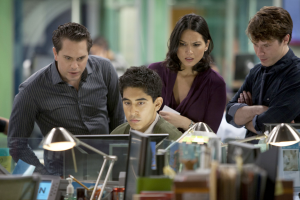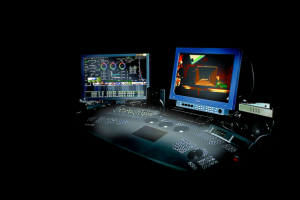Encore is one of the busiest full-service post-production facilities in Hollywood. Part of Deluxe Entertainment Services Group, the company has built its reputation primarily through its work in episodic television. It services such shows as Fringe, Glee, Justified, CSI: NY, Curb Your Enthusiasm and Hung, providing near-set dailies, colour grading, editorial finishing and visual effects. It also boasts one of the industry’s most efficient file-based workflows and was among the first to implement an ACES workflow for television.
Recently, Encore enhanced its colour grading resources through the addition of four Baselight grading systems. The new systems, which range from Baselight ONE to Baselight FOUR, are linked in a high-speed cloud network that allows colourists to work in a collaborative environment with grading tasks distributed in a unique manner.

The cloud network enables Senior Colourist Pankaj Bajpai to perform final grading for seven television series that are in production concurrently—Last Resort, Nashville, The Newsroom, 90210, Mob Doctor, Revenge and Justified. He manages what would otherwise be an impossible workload by concentrating his efforts on setting looks and performing other key aesthetic tasks and then passing projects onto colleagues for further processing.
“I have an incredible team,” Bajpai says. “I will start a scene, set the look and then my supporting colourists take over. I move onto other scenes. With Baselight, we are easily able to marry our work into a single timeline. At the same time, someone may be working on another Baselight and rendering our work. The Baselight Cloud works very, very well.”
“I equate our workflow to a restaurant,” Bajpai adds. “I’m like the head chef. I design recipes to satisfy the tastes of our customers. But, we also have sous chefs, dessert chefs and line cooks. We’ve worked it out so that everyone is aware of what’s needed and at the end it all returns to me. I finish every shot. This workflow allows me to do a lot of finessing as opposed to spending time on routine tasks.”
Encore’s incredible productivity is also facilitated by Baselight’s ability to work with virtually any type of media and its industry-leading processing speed. Bajpai notes that, with Baselight, he can work with different types of media in a single timeline. Given the variety of camera systems and media formats used in television production today that, he says, is essential. It’s also important to have a grading system that can process a high volume of data without slowing down.
“You’ve got to work in real-time at all times,” he says. “No matter how complicated the processing, no matter how complicated the grade, you cannot afford not. With theatrical work, you may be able to work with proxies, but not in television. It’s original media all the time, and with Baselight that’s not a problem.”

One of Bajpai’s latest projects is The Newsroom, HBO’s riveting drama that takes viewers behind-the-scenes of a network television news channel. The show is notable for its sparkling dialogue and brilliant acting, as well as its distinctive visual style. The camerawork mimics the restless energy of the newsroom environment with constant movement and unusual angles. The imagery has a gritty texture, with subtly visible grain that calls to mind news footage.
The show’s look originated with its pilot, which was shot on Super 16mm film by cinematographer Barry Ackroyd, BSC. When the show moved into regular production, cinematographer Todd McMullen stepped behind the lens and the show switched to digital capture via Arri Alexa.
Working closely with McMullen and with technical support provided by FilmLight U.S. Product Manager Peter Postma, Bajpai developed a novel approach that allowed him to apply a look to the digitally-captured media that replicates the filmic look of the pilot. Bajpai notes that Postma assisted in designing an ACES workflow for that show that provides added flexibility in handling Alexa camera media.
“Peter took the chip response of the Alexa and, using his colour science background and the toolset in Baselight, mapped it to a generic film response,” Bajpai recalls. “That, combined with the ACES workflow, allows me to work with the Alexa media as if it were film.”
Using Baselight’s powerful toolset, Bajpai applies several layers of looks to the camera media simultaneously. “It’s very much like Photoshop,” he explains. “We use actual film grain as well as a ‘cocktail’ of other processing to achieve the desired look. In this way, we were able to eliminate the soft focus and other problems of 16mm while creating the aesthetic the show wants.”
“The maths,” says Bajpai, “is very complicated, but the power of this system allows me to work in real-time. I am running multiple rows of media and blending them in a very sophisticated way. When you look at the show, you don’t really see all the dancing film grain, but it lends a wonderful organic-ness that viewers feel.”
Baselight is not only enhancing productivity and providing new creative options in post-production, it’s also facilitating new ways for managing colour on the set. Bajpai notes that he often works with his cinematographer clients in pre-production, helping them establish the look for their shows. Using Baselight, he creates LUTs tailored to specific camera systems and post-production workflows. Cinematographers use these LUTs during production for reference and they are also applied to show dailies. This resolves a persistent issue for cinematographers that has accompanied the shift to digital acquisition: a loss of control over the look of their imagery as it moves downstream.

“When cinematographers were shooting on film, the negative was processed in a lab and they had a degree of certainty about the look,” Bajpai explains. “In the lab the process was fixed. Chemicals were defined, timing and temperature were regulated. In the digital world, that has disappeared.”
The LUTs that Bajpai creates in Baselight provide cinematographers with a means for communicating their creative intent through the various stages of post-production. “It gives them the peace of mind,” he says. “It ensures that the imagery they shoot is going to be processed with the same degree of precision and care that they formerly received when they sent negative to a lab.”
The LUTs Bajpai creates in Baselight produce identical results no matter how, or through what system, they are later applied. “You can load them into an ARRI camera, into an on-set box, or into most other grading systems, and the results will be the same,” he says. “It creates a very predictable path that does not depend on a dailies colourist applying what he thinks is the right Log C to Rec 709 conversion. It is fool-proof.”
Smart colour management is more important than ever, both on the set and in the grading suite, says Bajpai, and Baselight provides the tools necessary to work with colour in the most creative and efficient way possible. “It’s important that people understand how far we can push it,” he concludes. “It’s truly incredible.”



